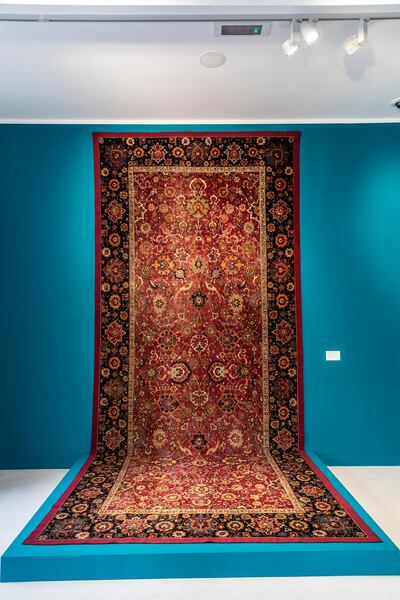Christie’s in the DIFC is showcasing highlights from its coming Art of the Islamic and Indian Worlds sale.
The auction, taking place on October 27 in London, includes ceramics, manuscripts, textiles, metalwork, carpets and works on paper from across the Islamic world. Iznik pottery is on display alongside a sword belonging to Tipu Sultan, one of the British Army's most feared enemies in the 18th century.
The pieces span the 9th and 20th centuries, covering much of the Islamic world, from Spain to Central Asia.
They are on display until Thursday and include a 16th-century Iznik pottery dish from Ottoman Turkey, which is valued at up to $150,000. Its pattern is thinly painted in a colour known as bole red, leaving the white ground to show in patches.
The town of Iznik was known for its traditionally crafted hand-painted tiles and ceramics during the Ottoman era. Many facets of the tradition were heavily influenced by the introduction of Chinese porcelain into the region.
“Through the 14th and 15th centuries Chinese porcelain was imported into the Islamic world and it was really treasured as a prized possession,” Sara Plumbly, a director at Christie’s, tells The National.
“Ottoman sultans asked: 'What are we going to do? How are we going to respond to this? What are we going to make?' So, they set up a site in this town of Iznik and started producing work at the very end of the 15th century, and carried on through the 16th and into the 17th centuries.”

Another piece on display is a sword and scabbard from the personal armoury of Tipu Sultan, who ruled Mysore, south India, from 1782 to '99.
The sword and its sheath, valued at up to $2.5 million, are from the estate of Charles Cornwallis. The family was presented with the sword after the death of the Muslim ruler at the fall of Seringapatam in the 18th century, and it has been passed down through the generations ever since.
“Tipu Sultan was a brilliant ruler. He was very successful militarily, led a very strong army and was, I think it's safe to say, the most serious opponent to the British and their time in India,” Plumbly says.
“He proved a real difficult enemy for them to overcome. He was very forward-thinking and a very cultured man. He was also very interested in the technologies of the West, including their military technology, which he used against the British in the end.”
Tipu was associated with the symbolism of the tiger, Plumbly says, so much so that he was known as the Tiger of Mysore. Tipu used the tiger motif in arms, armour, buildings and his throne. It is on the sword, too, including the hilt and its stripped pattern called Bubri.
The sword also includes verses from different passages of the Quran.

From the rugs and carpets portion of the auction is The Baron Edmond de Rothschild Royal Safavid.
The carpet, estimated to be worth $2.5 million to $3.7 million, was owned by both the Rothschild and Getty families at different times and was possibly woven in Qazvin, which was then North Persia, in the 16th century.
It is thought to date back to 1565 and was made by a group of artisans using wool pile on a silk and cotton foundation.
A burgundy red field is covered with an ornate network of scrolling vines, where the motifs of palmettes, blossoms, buds and leaves almost mirror one another on each side of the carpet, along with a number of paired pheasants with colourful plumes.
The Art of the Islamic and Indian Worlds exhibition is running at Christie’s Dubai until Thursday





